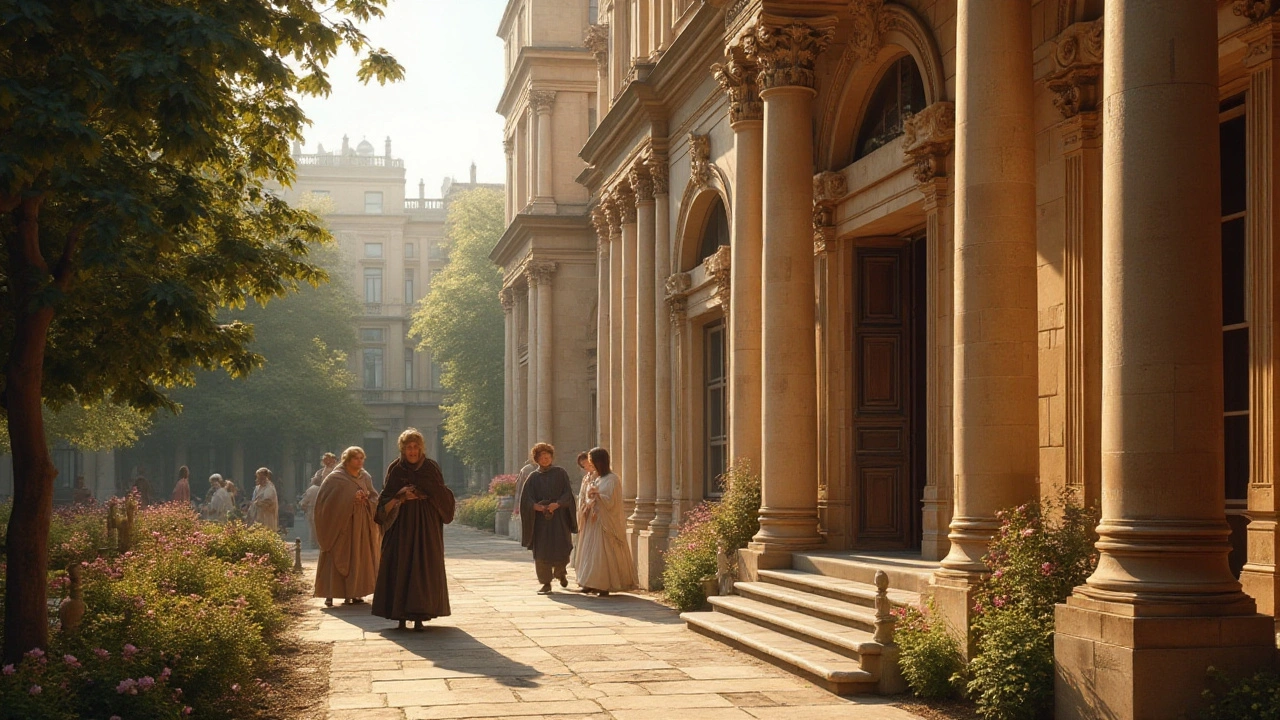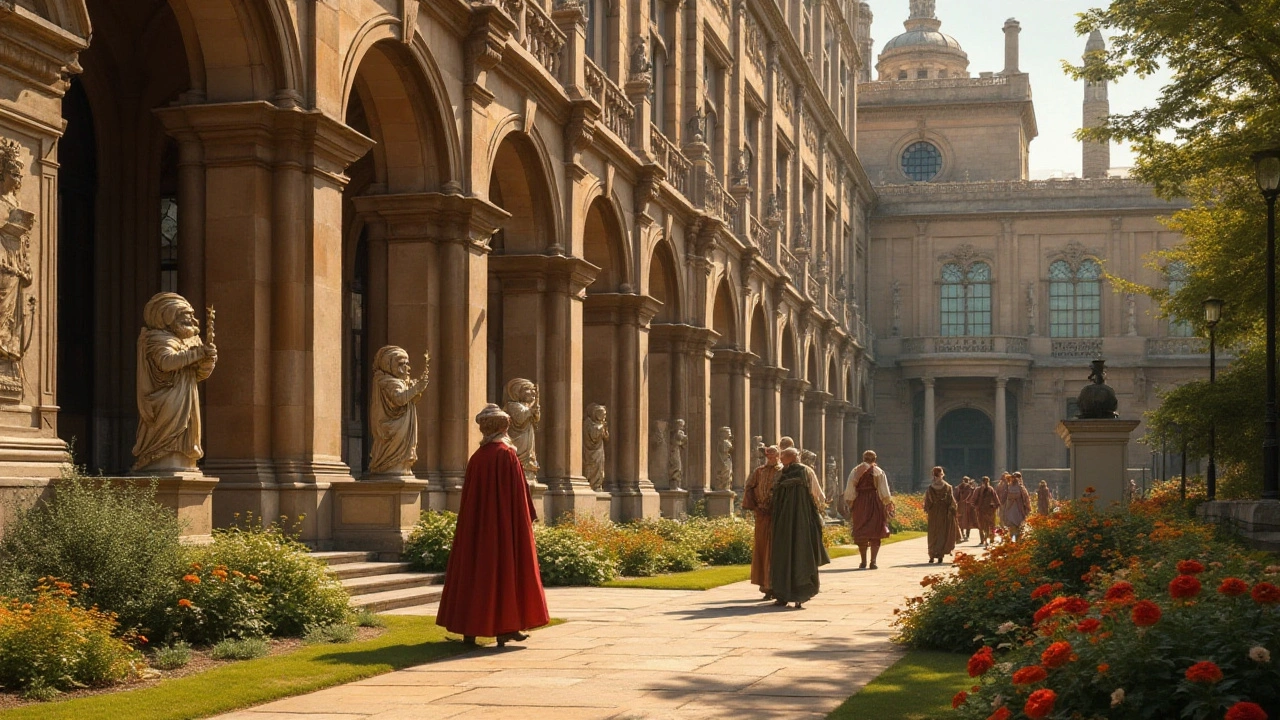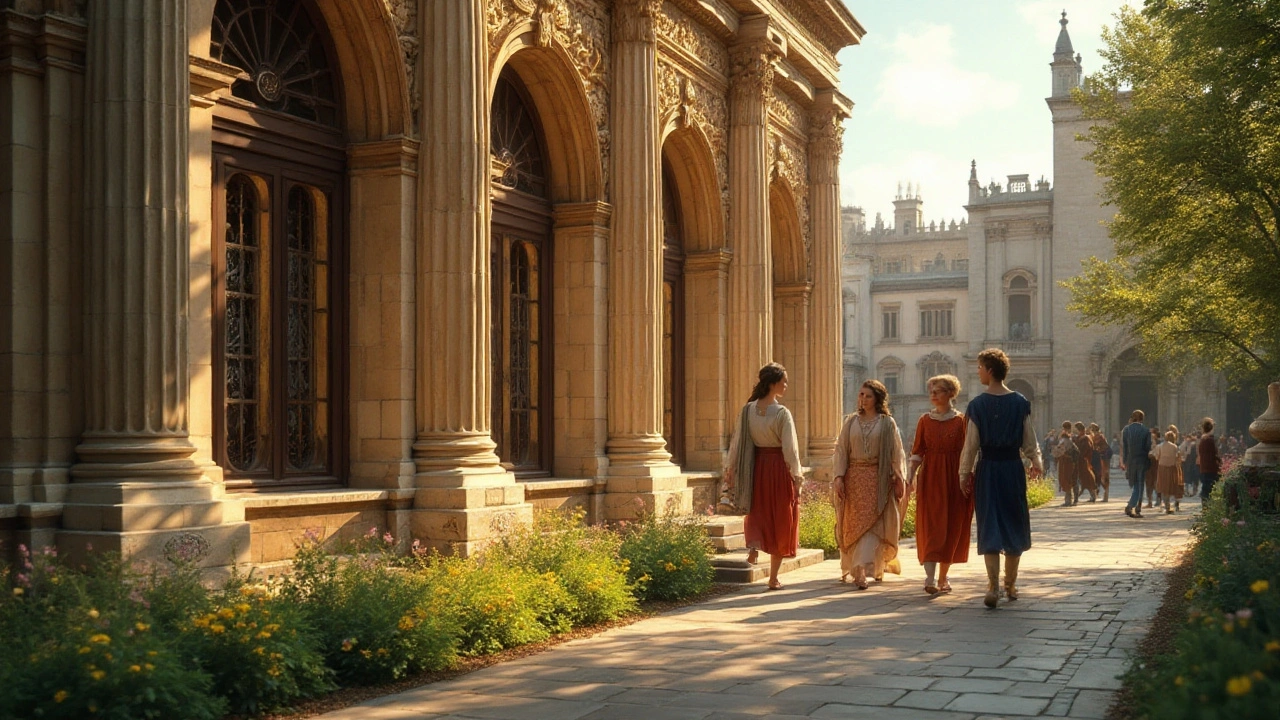Exploring Renaissance Architecture: The Art of Enlightenment and Innovation
 Aug, 17 2024
Aug, 17 2024
Stepping into the world of Renaissance architecture is like opening a book to a grand age of enlightenment and pristine artistry. Originating in the 14th century in Italy, this style revived classical Greek and Roman ideas, marrying them with new-found humanist ideals.
The architectural elements that emerged during this period reflected a harmonious blend of symmetry, proportion, and geometry, symbolizing the intellectual awakening of Europe. Renaissance architecture wasn't just about buildings; it was about expressing a renewed cultural spirit and intellectual fervor.
With masterminds like Brunelleschi, Michelangelo, and Palladio shaping the skylines of cities like Florence, Rome, and Venice, each edifice stood as a testament to innovation and beauty. From domes and columns to arches and ornamental details, every feature had a story, a purpose, and a place in this rich historical tapestry.
Even today, the influence of Renaissance architecture is palpable. It not only changed the face of its time but also paved the way for future architectural endeavors, imbuing them with a sense of elegance and intellectual pursuit. Let's delve deeper into the fascinating aspects of this architectural style and uncover the secrets that have made it timeless.
- Historical Context of Renaissance Architecture
- Key Characteristics and Elements
- Influential Architects and Iconic Buildings
- Enduring Legacy and Influence in Modern Architecture
Historical Context of Renaissance Architecture
The Renaissance was a period of revival, a blossoming of art, culture, and intellect starting in the 14th century in Italy. Specifically, Renaissance architecture marked a deliberate look back at classical antiquity, embracing the symmetry, geometry, and proportion of ancient Greek and Roman buildings. This era was born out of the devastation of the Middle Ages, a direct response to the chaos and disorder that had previously troubled Europe.
Florence is often considered the cradle of Renaissance architecture. In the early 1400s, the city was a hub for commerce and wealth, which allowed patrons like the Medici family to finance monumental projects that expressed this burgeoning cultural and intellectual awakening. Filippo Brunelleschi played a pivotal role, returning to classical principles to design structures like the dome of the Florence Cathedral. His work was revolutionary, setting the standard for architectural practice across Europe.
The influence of the Renaissance was not only confined to architectural projects; it spread through various mediums such as painting and sculpture, creating a holistic cultural shift. Humanism, an intellectual movement that focused on human potential and achievements, inspired architects and artists. This movement encouraged a focus on worldly subjects rather than solely religious ones, which is a significant departure from the Gothic style that preceded it.
During this period, the written discourse on architecture also flourished. Leon Battista Alberti, an architect and a scholar, published his seminal work, 'De Re Aedificatoria', which served as a comprehensive guide to the principles of architecture, emphasizing the importance of harmony and proportion. He famously said, "Beauty is the harmony and concord of all parts achieved in such a manner that nothing could be added, diminished, or altered except for the worse."
The impact of the Age of Enlightenment is palpable. As European nations began to stabilize politically and economically, they started to invest in the cultural capital that seemed to promise a brighter future. This period saw the construction of many iconic structures, such as the Tempietto by Donato Bramante in Rome, which showcased the harmonious proportions inspired by classical antiquity.
Trade routes opened up new avenues of cultural exchange, and the spread of Renaissance ideas was swift. Architectural elements from this period, like domes, columns, and pilasters, began to appear in cities far removed from Italy, such as Paris and London. With the aid of printed books and treatises, knowledge of architectural principles and techniques could easily traverse borders and social classes.
The Renaissance was not just limited to architecture’s structural form but also its philosophy. Architects began to view their work as an intellectual pursuit, involving rigorous study of mathematics, geometry, and perspective. This period’s attention to detail can be seen in city planning initiatives as well, where entire urban landscapes were designed following humanist ideals. Streets, public squares, and civic buildings were laid out with careful consideration of symmetry and order.
Even today, the marvels of Renaissance architecture continue to inspire and educate. The era's principles have left an indelible mark on architectural history, serving as a foundation for subsequent architectural styles and movements. Renaissance buildings are more than mere structures; they are a testament to an age that valued beauty, intellect, and human potential.

Key Characteristics and Elements
Renaissance architecture is a beacon of beauty and intellect, blending mathematical principles with artistic expression. This fusion erupted in the 14th century and evolved continually until the 17th century, predominantly in Italy but spreading across Europe. One of the core characteristics was a shift from the medieval Gothic style's complexity and verticality to a more balanced and proportionate approach emphasizing horizontal lines. The architecture of this era celebrated rationality and humanism, influenced by classical antiquity's careful study.
Symmetry and proportion were foundational principles. Inspired by Roman architects like Vitruvius, Renaissance builders created structures where every part was harmoniously related to the whole. This proportion wasn't merely aesthetic; it was seen as a reflection of the divine order, a belief that numbers governed the universe's harmonies. As Alberti, one of the pivotal theorists of the time, famously noted, “Beauty is the adjustment of all parts proportionately so that one cannot add, take away, or alter without impairing the harmony of the whole.”
Another notable aspect is the use of geometric forms. Circles and squares were favored, often manifesting in the ground plans and elevations of buildings. Domes, too, became a significant feature, with the Florence Cathedral’s dome by Filippo Brunelleschi standing as a masterpiece of Renaissance ingenuity. Its double-shell design was revolutionary, influencing countless structures after it. The importance of geometric balance extended to facades, which were often tripartite, dividing the elevation into neat sections, thus emphasizing balance and order.
Columns and pilasters, borrowed from ancient Greek and Roman architecture, were ubiquitous in Renaissance buildings. Architects utilized the classical orders - Doric, Ionic, and Corinthian - to add elegance and structure. These elements were meticulously studied and replicated, demonstrating the Renaissance commitment to classical revivalism. The use of arches, another classical feature, added both structural integrity and visual beauty. Rounded or semicircular arches replaced the pointed Gothic ones, creating a more tranquil and stable appearance.
Decorative details were crafted with remarkable precision and creativity. Ornate cornices, friezes, and moldings adorned buildings, telling stories and showcasing craftsmanship. The use of relief sculpture helped enrich facades and interiors, often depicting biblical scenes, mythological figures, or allegories of the human experience. Renaissance architects sought not just to create functional buildings but also to imbue them with meaning and beauty that spoke to the intellect and soul.
In urban planning, Renaissance principles transformed cities. Streets were laid out in a more ordered manner, public squares became focal points, and buildings were arranged to enhance aesthetic appeal and functional harmony. This planning was evident in cities like Florence and Rome, where architecture was an integral part of the civic identity and cultural aspiration. It was an age where architecture transcended mere construction to become a representation of societal values and intellectual pursuit.
The attention to color and material choice also distinguished Renaissance architecture. Materials like marble, stucco, and terracotta were used not just for their structural properties but for their aesthetic appeal. Color schemes were carefully selected to enhance the visual harmony and thematic resonance of the buildings. Artists and architects worked hand in hand, ensuring that every detail, from the grandest to the minutest, contributed to the overall cohesive beauty.
Renaissance architecture’s legacy is profound and enduring. It has continued to inspire and inform architectural practice for centuries, symbolizing a pivotal moment when art, science, and philosophy were interwoven to elevate human creativity. By understanding these characteristics and elements, one can appreciate the meticulous thought and profound beauty embedded in every structure from this golden age of human achievement.
Influential Architects and Iconic Buildings
The Renaissance era saw the rise of some of the most influential architects who left an indelible mark on architectural history. Among these, Filippo Brunelleschi stands out prominently. Brunelleschi, an Italian designer and a key figure in architecture, is perhaps best known for developing linear perspective and engineering the dome of the Florence Cathedral. This dome, which remains one of the largest brick and mortar domes ever constructed, serves as a testament to the ingenuity and creativity of Renaissance architecture.
Another architectural luminary of the Renaissance was Leon Battista Alberti. Alberti made significant contributions with his treatise 'De re aedificatoria,' which outlined the principles of architecture based on classical antiquities. His works, including the façade of Santa Maria Novella in Florence, exemplify his mastery in creating harmonious proportions and integrating architectural elements seamlessly.
Michelangelo Buonarroti is another iconic figure whose influence on Renaissance architecture cannot be overstated. Known more widely for his sculpting and painting, Michelangelo's architectural endeavors are equally remarkable. His design of the Laurentian Library in Florence broke conventional architectural norms with its innovative use of space and daring staircases. Additionally, his work on St. Peter’s Basilica in Vatican City embodies the grandeur and spirit of the Renaissance.
"The greatest artists have risen from humble beginnings and have achieved greatness by reforming the beauty in classical forms." - Giorgio Vasari
Donato Bramante, a master of Renaissance architecture, introduced the High Renaissance style. His Tempietto, a small commemorative martyrium in the courtyard of San Pietro in Montorio in Rome, is a perfect example of classical architecture’s revival. Its perfect symmetry and elegant proportions mark a high point in Renaissance architectural design.
Iconic Buildings
Many iconic buildings from the Renaissance period continue to awe and inspire us today. The Palazzo Vecchio in Florence, with its fortress-like build and towering Arnolfo Tower, is a striking example of civil architecture from this period. Inside, the extensive frescoes and decorations illustrate the artistic brilliance of the era.
The Vatican's St. Peter's Basilica, designed by a medley of architects including Bramante, Michelangelo, and Raphael, stands as an epitome of Renaissance architecture. Its grand dome, an engineering marvel of its time, not only dominates the Roman skyline but also symbolizes the power and influence of the Renaissance Church.
In Venice, the Library of St. Mark, or Libreria Marciana, highlights the artistry of Jacopo Sansovino. This building, with its ornate façade and intricate columns, underscores the importance of knowledge and the intellectual rebirth that characterized the Renaissance.
The Château de Chambord in France, designed by Domenico da Cortona, represents the spread of Renaissance architecture beyond Italy. This grand chateau combines medieval forms with classical Renaissance structures and is surrounded by expansive grounds that further emphasize its grandeur.
Indeed, the Renaissance period was marked by a remarkable fusion of art, science, and philosophy, all culminating in the awe-inspiring architecture that continues to captivate us. These architects and their creations not only shaped their era but also laid the groundwork for future generations, influencing modern architecture in ways that remain evident in our cities today.

Enduring Legacy and Influence in Modern Architecture
The profound influence of Renaissance architecture persists even in the fabric of modern architectural practices. This enduring legacy can be seen in various facets of contemporary design, from public buildings to private residences.
One clear example of this influence is the ongoing appreciation for balance, symmetry, and proportion that characterized the Renaissance. Modern architects continue to draw inspiration from these principles, integrating them into their designs to create visually appealing and functional spaces. The use of columns, domes, and arches in modern structures serves as a homage to the classical ideals reawakened during the Renaissance period.
Philippe de Montebello once remarked, "Great architecture has only two natural enemies: water and stupid men." This profound respect for architectural integrity is clearly rooted in the Renaissance, a time when the beauty and durability of buildings were of paramount importance.
Moreover, the Renaissance's emphasis on intellectual and cultural renewal is mirrored in modern architecture's focus on innovation and human-centric design. Just as Renaissance architects applied mathematical concepts to create harmonious structures, today's architects use advanced technology and creative problem-solving to achieve similar goals. The humanist philosophy of the Renaissance, which encouraged a blending of art, science, and humanities, continues to resonate in the multidisciplinary approaches applied in modern architecture.
One iconic example is the United States Capitol in Washington, D.C. Modeled after St. Peter's Basilica in Vatican City, the Capitol's grand dome and impressive use of space reflect Renaissance-inspired ideals. Even in contemporary skyscraper design, elements such as tall, graceful facades and meticulously planned layouts echo the symmetry and grandeur of Renaissance buildings.
Historical buildings from the Renaissance era still stand tall, not just as relics of a bygone age but as vibrant sources of inspiration for new generations of architects. The innovative use of materials and technologies in the Renaissance often find parallels in today’s eco-friendly and sustainable architectural practices. Principles such as light management, natural ventilation, and the thoughtful placement of structures within their environment illustrate how Renaissance ideas can be adapted to meet modern needs.
There’s an unmistakable thread of continuity that links these two eras. By studying the ingenuity and creativity demonstrated in Renaissance structures, modern architects gain insight into timeless design principles. The learnings from this rich historical period help inform the creation of buildings that are not only aesthetically pleasing but also deeply functional and enduringly relevant.
In essence, the Renaissance never truly ended—it simply evolved. Its principles of harmony, innovation, and intellectual pursuit continue to underpin much of today’s architectural achievements, echoing the timeless legacy of an age of enlightenment. This enduring influence ensures that Renaissance architecture remains a touchstone for excellence in the vast, ever-evolving world of architectural design.